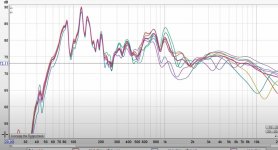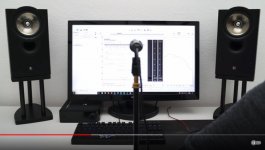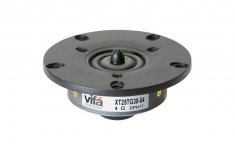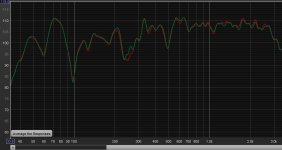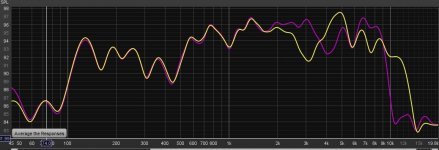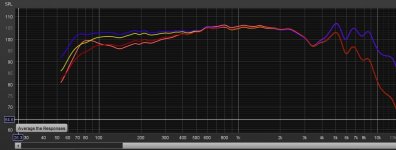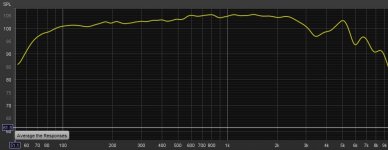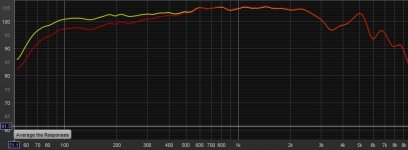interestingly i was watching an online video on REW, and the guy took some measurements of his bookstand speakers, I took a screencapture of the graph .... his 70hz + 250hz dips are almost identical to mine , so these must be very common low freq. room responses
Attachments
True you do not know what the the driver are, but we could guesstimate.
Choose any paper 5 inch paper cone with the correct 8 ohm impedance from any of the major manufacturers basic range. Thehe guesstimates could be used in the Sw?
In the Xover range for the bass to the mid at 200Hz the frequency response of most 5 inchers is going to be reasonably flat, and probably not even starting to climb due to baffle step, also impedance isn't zooming of at that frequency. That would allow you to get a feel for the Xover interaction and could possibly help.
The midrange seems to be starting to decline at 3KHz so that could be a useful frequency to look at for integrating the mid to the tweeter. What type of the driver is the tweeter, is it dome, or hybrid?
Choose any paper 5 inch paper cone with the correct 8 ohm impedance from any of the major manufacturers basic range. Thehe guesstimates could be used in the Sw?
In the Xover range for the bass to the mid at 200Hz the frequency response of most 5 inchers is going to be reasonably flat, and probably not even starting to climb due to baffle step, also impedance isn't zooming of at that frequency. That would allow you to get a feel for the Xover interaction and could possibly help.
The midrange seems to be starting to decline at 3KHz so that could be a useful frequency to look at for integrating the mid to the tweeter. What type of the driver is the tweeter, is it dome, or hybrid?
You are right room modes effect all of the measurement we take in room, and it can be simulated and modelled if you have the time. For me 200Hz is the biggest problem. I get a big dip that makes my graphs look terrible. There are are other modes but they are smaller.
You can move the speakers around in your room to get an improvement, or live with what have.
In terms of tuning your loudspeakers you will probably have to mentally average through the peaks and the troughs of the room response. As you alluded to in an early post 1st order smoothing make it look much better, and match this to your mid and tweeter.
Trying to make a flat response may not give you your the sound you want, just keep listening as you tune. Be prepared to go through another re tuning when you add the tweeter as this very easily can unsettle the balance.
Selective use of resistors in the series and shunt branches of the tweeter circuit can be used to change slope and level as required. A coffee or two and thirty minutes to an hour or so with a sim can help sort this.
You can move the speakers around in your room to get an improvement, or live with what have.
In terms of tuning your loudspeakers you will probably have to mentally average through the peaks and the troughs of the room response. As you alluded to in an early post 1st order smoothing make it look much better, and match this to your mid and tweeter.
Trying to make a flat response may not give you your the sound you want, just keep listening as you tune. Be prepared to go through another re tuning when you add the tweeter as this very easily can unsettle the balance.
Selective use of resistors in the series and shunt branches of the tweeter circuit can be used to change slope and level as required. A coffee or two and thirty minutes to an hour or so with a sim can help sort this.
Hi,
To get the most out of the given speakers, ultimately I would probably bi-amp them and give them active XOs. Failing that, depending on the amp, it may or may not be sensitive to phase offsets from all the passive components and driver impedances. If you could find a way to measure the impedance and phase vs frequency, that would also tell you more about the drivers and how hard they are on the amp.
High-passing the mid is probably a good start and would reduce modulation from excess bass.
Zobel networks are under-rated IMO, and applied in parallel around each driver separately to flatten the impedance would probably make the XO more predictable. Good quality caps also matter, like polypropylene.
These are just some ideas. YMMV🙂
To get the most out of the given speakers, ultimately I would probably bi-amp them and give them active XOs. Failing that, depending on the amp, it may or may not be sensitive to phase offsets from all the passive components and driver impedances. If you could find a way to measure the impedance and phase vs frequency, that would also tell you more about the drivers and how hard they are on the amp.
High-passing the mid is probably a good start and would reduce modulation from excess bass.
Zobel networks are under-rated IMO, and applied in parallel around each driver separately to flatten the impedance would probably make the XO more predictable. Good quality caps also matter, like polypropylene.
These are just some ideas. YMMV🙂
The midrange seems to be starting to decline at 3KHz so that could be a useful frequency to look at for integrating the mid to the tweeter. What type of the driver is the tweeter, is it dome, or hybrid
yes , i will try a 3500hz xover for the tweeter ( PEERLESS VIFA XT25TG30-04, )
that tweeter was installed by a previous owner, the original tweeter was a DTR 25E (Emit-R)
i will do a manual impedence measurement using a multi meter / voltage diver method , as the REW method need a strong headphone output + custom made cable, prefer to see the impedence graph from my amplifier ouput
https://audiojudgement.com/loudspeaker-impedance-measurement/
i agree, active would be best , but for now i can smooth out any peaks using a Behringer DEQ2496 DSP / RTA , so keen to keep the xover as simple as possible
Attachments
zobel networks are under-rated IMO, and applied in parallel around each driver separately to flatten the impedance would probably make the XO more predictable. Good quality caps also matter, like polypropylene.
These are just some ideas. YMMV🙂
i did try with and without a zobel on the mid, the red line is with a zobel...... not really much difference?
Attachments
A decent tweeter for that kind of Xover freq.
With the Behringer and DEC2496 as backup you should be good to finish this with a few more tweaks.
With the Behringer and DEC2496 as backup you should be good to finish this with a few more tweaks.
yes i hope so , ive changed + chosen the final xover values , which give a pretty good freq. response ( i think! ) ( i like the 2k-3k dip ) ...... however the mid seems to lift up again between 4k - 5.5k , could this be just a room mode?A decent tweeter for that kind of Xover freq.
With the Behringer and DEC2496 as backup you should be good to finish this with a few more tweaks.
i did try with a zobel, but it made no difference ( the graph is with Psychoacoustic smoothing on )
Attachments
With zobels if there's a difference it would be with HD moreso than EQ.i did try with and without a zobel on the mid, the red line is with a zobel...... not really much difference?
Is the tweeter mounted internally so it is firing out through the shaped baffle, used for the original tweeter? Maybe a standalone tweeter measurement would show how it behaves.
As to the mids coming back up again at 4-5Khz is that purely the midrange? and you haven't added any other components?
As to the mids coming back up again at 4-5Khz is that purely the midrange? and you haven't added any other components?
thats the midrange measurement, with the bandpass componentsIs the tweeter mounted internally so it is firing out through the shaped baffle, used for the original tweeter? Maybe a standalone tweeter measurement would show how it behaves.
As to the mids coming back up again at 4-5Khz is that purely the midrange? and you haven't added any other components?
the tweeter is mounted behind the baffle , ive not added any components to it, or connected it yet ... but will do v soon
Last edited:
tweeter measurements today, 2nd order 2.2uF +3.1mH ( need smaller coils , on order, ) ..... taken on axis, 1m , mic at tweeter level ...midrange is running without xover ( as working with loose cables, need to make a test board, but i think it gives me a good idea of the mid/tweet interaction )
i had to reverse polarity on the mid, note the extended freq. response with the mid reversed ( yellow line ) ;
i had to reverse polarity on the mid, note the extended freq. response with the mid reversed ( yellow line ) ;
Attachments
A smaller coil yes, something below 0.5mH I am guessing, maybe as low as 0.18mH.
As its a tweeter on axis I would have thought you would have managed easily above 15KHz, but the mike and its calibration could be a factor here for accurate measurements.
The fact that you managed a higher response with the mid reversed shows they must be fighting each other.
As its a tweeter on axis I would have thought you would have managed easily above 15KHz, but the mike and its calibration could be a factor here for accurate measurements.
The fact that you managed a higher response with the mid reversed shows they must be fighting each other.
A smaller coil yes, something below 0.5mH I am guessing, maybe as low as 0.18mH.
As its a tweeter on axis I would have thought you would have managed easily above 15KHz, but the mike and its calibration could be a factor here for accurate measurements.
The fact that you managed a higher response with the mid reversed shows they must be fighting each other.
sorry i meant 0.31mH , not 3.1mh... i will try a 0.2mH next as readily available
I installed Xsim + found / loaded the raw freq. and impedence files for this XT25 driver
the best curve I created was -12db 1 octave down from the 3.5k xover point , with a minimal bump in the 6k region....
components are 11uF + 0.2mH, so yes you were absolutely spot on with the inductor value i needed , thanks(!)
the best curve I created was -12db 1 octave down from the 3.5k xover point , with a minimal bump in the 6k region....
components are 11uF + 0.2mH, so yes you were absolutely spot on with the inductor value i needed , thanks(!)
Attachments
im not sure, the above measurement was with mid + HF only, so hopefully with the woofer connected it may bump at that region.... really dont know at the moment , but the mid+HF seem ok as they are right now, will have them all connected once the 0.2mH inductors arriveWhat do you think about the jump around 500-600?
Last edited:
What do you think about the jump around 500-600?
quick update , i retested with a different Zobel , and this has really flattened out the freq.response, the 500hz jump has gone , or at least , its now under 1.5db
and also huge difference at the 5k point, now its dropping off correctly ( graph is midrange only measurement/s 0.31mH + 60 / 120 / 240uF combinations ) i like the look of the yellow curve the most ( 240uF ) though i may need a shallower slope once the bass is connected, should be just a matter of changing the cap value on the mid..... all 1/6 smoothing
Attachments
Last edited:
- Home
- Loudspeakers
- Multi-Way
- help needed choosing one of these xover slopes ( graphs attached )
